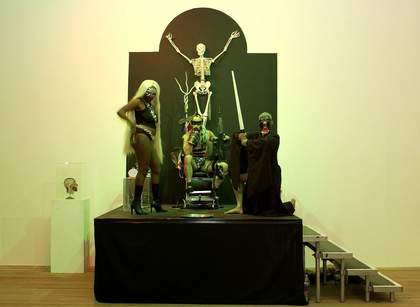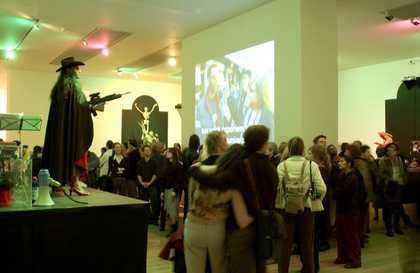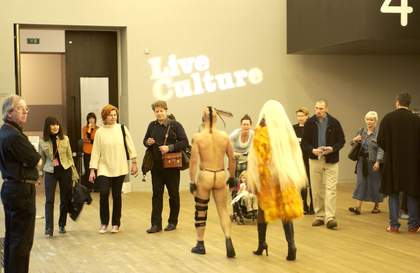Ex Centris (A Living Diorama of Fetish-ized Others) was an installation and performance by the Mexican-American artist Guillermo Gómez-Peña. Originally conceived in 2002 for the Liverpool Biennial of Contemporary Art International Exhibition, the work was an inter-continental collaboration between the Live Art Development Agency, Bluecoat Arts Centre, the Liverpool Biennial, motiroti and La Pocha Nostra, the international, interdisciplinary performance collective formed by Gómez-Peña in 1993. Ex Centris (A Living Diorama of Fetish-ized Others) was then re-performed by Gómez-Peña, along with collaborators Juan Ybarra, Michelle Ceballos of La Pocha Nostra, Kazuko Hohki and Ansuman Biswas, at Tate Modern as part of Live Culture, a programme of performance events which took place at the gallery between 27 and 30 March 2003.
Ex Centris (A Living Diorama of Fetish-ized Others) addressed cultural and racial fetishism, through a series of interactive dioramas: a mode of display associated with museums, circus acts and window displays. During the performance audience members were confronted by the performers standing on top of constructed plinth-like platforms and wearing kitsch costumes. They were presented as ‘artificial savages’, armed with a wealth of props to aid their performance, which they swapped and changed around throughout. Gómez-Peña, for example, was a mix of Chicano, American cowboy and transvestite. In his choice of hat he alternated between a Stetson and a sombrero, teetered on stage in a pair of red high heels and brandished a toy gun before the audience. Other characters similarly presented bizarre hybridisations of ‘otherness’, weaving elements of cultural stereotyping with explicit references to realms of fantasy and of violence. On one platform stood a black, ghetto super-woman clad in gold chains, crotch-length blond wig and tight black underwear, with her face painted gold; on another a militarised Apache Indian, with feathers attached to his painted scalp and a machine gun in his hand; and elsewhere a light-saber wielding alien. Other performers sported niqabs and saris, dominatrix-style outfits, UK and US flags and a range of headgear. Some simply presented themselves naked, offering their bodies for the audience to gaze at, and even to touch. During the last hour of the performance, audience members were allowed to direct the dioramas, choosing from a menu of possible interactions, which included changing performers’ props and costumes, whipping or roughly handling them, tagging them with spray paint and pointing replicas of handguns and Uzis at them. In encouraging such an interaction between audience and performer – the looker and the looked at – Gómez-Peña sought to actively implicate all participants in the violence induced by cultural stereotyping, and in doing so create a ‘ceremonial space’ in which the audience, as participants, could reflect on their ‘relationship with cultural, racial and political Otherness’.1
Ex Centris (A Living Diorama of Fetish-ized Others) referenced elements of anthropology, technology, advertising and pop-culture to highlight the continued fetishisation of the ‘other’ across all spheres of Western culture and to critique colonial practices of representation, which have tended to demonise and ridicule certain bodies while romanticising and sexualising others. Channeling cultural pathologies, the hybridised characters of Ex Centris performed these cultural and racial stereotypes, overloading and juxtaposing these characters and symbols so that they became unreadable. By staging these highly fetishised bodies as images – placing them in front of painted backdrops and displaying them as if part of the museum collection – the performance addressed how marginalised identities have, and continue to be, represented within institutions like museums and art galleries. Furthermore, it posed questions about how identity is constructed, represented and read in an era of increasing multi-culturalism, globalisation and advanced technology.
Live Culture was supported by Arts Council England, Live Art Development Agency, The Felix Trust for Art and The Henry Moore Foundation. Bringing together artists, theorists and curators, Live Culture explored the shifting nature of live art practice in relation to the visual arts and examined the expansion of performance art through a series of live events. In particular, the programme explored the role of performance in relation to cultural change and highlighted the ways in which the term live art encompassed an array of contemporary practices, which employed performance as a generative force to play with truth and pretence, and to break apart traditional representational codes.
Clare Gormley
October 2015



